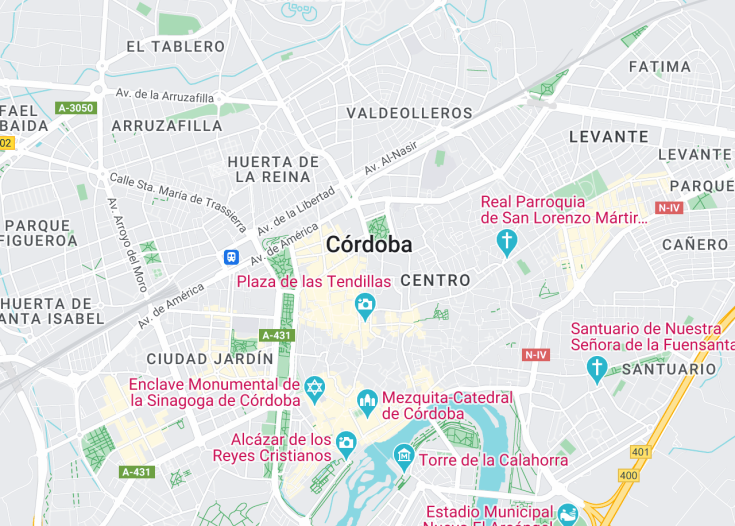Cordoba, Spain, is a captivating city rich in history and culture, renowned for its architectural splendors from the Roman, Islamic, and Christian periods. The heart of Cordoba’s historical intrigue is the mesmerizing Mezquita, a cathedral-turned-mosque that showcases a blend of Islamic art and Gothic architecture. Beyond its historical canvas, Cordoba offers vibrant festivals, like the famous Patio Festival, where residents decorate their courtyards with flowers. The city’s ancient charm combined with its lively cultural scene makes it a must-visit destination for anyone exploring southern Spain.
Remember to visit during May to experience Cordoba at its most colorful and vibrant, when the city comes alive with the Patio Festival.
Consider taking a guided walking tour to fully appreciate Cordoba’s rich history and architectural marvels, making sure not to miss the Jewish Quarter.
Top things to do & see in Cordoba
Select the following sights and activities to discover best tickets and tours available in Cordoba.
Cordoba: A Glimpse into Spain’s Enchanting History
| Country | Spain |
| Time in Cordoba | GMT+1 |
| Language spoken | Spanish |
| Population | 325,701 (Source: Instituto Nacional de Estadística, 2021) |
| Currency | Euro (EUR €) |
| Airports |
|
Cordoba, located in Southern Spain, is a captivating city that illustrious for its unique blend of Roman, Islamic, and Christian history, evident in its architecture and cultural sites. Once a significant Roman city and an Islamic cultural center in the Middle Ages, Cordoba is now a UNESCO World Heritage City, famed for its historic cordiality and vibrant modern life.
Where is Cordoba?
Located in the heart of Andalusia in Southern Spain, Cordoba is well-positioned along the Guadalquivir River.
Distances:
| Route | Distance by car | Time by car |
|---|---|---|
| Madrid to Cordoba | 240 mi / 386 km | Approx. 4 hours |
| Seville to Cordoba | 87 mi / 140 km | About 1 hour 30 minutes |
| Granada to Cordoba | 100 mi / 161 km | About 2 hours |
What is Cordoba famous for?
Cordoba is renowned for its mesmerizing Mezquita, a cathedral-mosque that stands as a monument to the city’s diverse religious history. Its winding historic streets and the annual Festival of Patios add to its charm.
History
Exploring the rich historical tapestry of Cordoba involves delving into a past that is both profound and diverse. Established and shaped by various civilizations, Cordoba is a city that boasts a unique narrative spanning thousands of years.
Pre-Roman and Roman Period (Pre-206 BC – 5th Century AD)
The area around Cordoba has been inhabited since the Neolithic age, showcasing a variety of cultures including the Iberians. The city’s strategic importance was recognized early on, and it flourished significantly under Roman rule after being captured in 206 BC by general Marcellus. Known then as Corduba, the city served as a capital of the Roman province of Hispania Ulterior. It was during this time that Cordoba gained many of its architectural and infrastructural upgrades, including an impressive aqueduct system.
Islamic Golden Age (711-1236)
The arrival of the Moors in 711 marked the beginning of Cordoba’s golden age. Under the Umayyad Caliphate, the city became one of the largest and most advanced cities in the world, known especially for its contributions to science, culture, and the arts. The construction of the Great Mosque of Cordoba, which remains one of the city’s most significant monuments, dates from this period. Cordoba was recognized as a center of learning and intellect, attracting scholars, poets, and philosophers from across the Islamic world and Europe.
Reconquista and Christian Rule (1236 – Modern Period)
Cordoba was conquered by King Ferdinand III of Castile in 1236, bringing it under Christian rule. The city’s mosques were converted into churches, and the Great Mosque was transformed into a cathedral, yet it retained its stunning Islamic architecture. Throughout the Middle Ages and into the modern period, Cordoba continued to be an important cultural and economic centre, though it never regained the pre-eminent status it held during the Islamic Golden Age. Today, Cordoba is celebrated for its historical amalgam of Jewish, Islamic, and Christian influences.
Visit Cordoba
What to see and do in Cordoba, Spain
Discover the timeless beauty of Cordoba, a city that seamlessly blends its historical past with the vibrancy of modern life. Key attractions include:
- The Great Mosque of Cordoba (Mezquita-Catedral), a stunning example of Islamic architecture with a Gothic cathedral at its heart.
- The Alcazar of the Christian Monarchs, featuring beautiful gardens and impressive historical rooms.
- The historic Jewish Quarter, with its narrow lanes and the ancient Synagogue.
- The Roman Bridge and Calahorra Tower, offering panoramic views of the city.
- Palacio de Viana, noted for its patios and lush gardens.
Festive Celebrations in Cordoba
Cordoba is host to several vibrant events throughout the year, notably the Cordoba Patio Festival in May, where residents open their beautifully decorated courtyards to the public. The city also celebrates a spectacular Holy Week (Semana Santa), characterized by its solemn processions and emotive performances.
Best time to visit Cordoba
The ideal time to visit Cordoba is during the spring (April to June) when the weather is pleasantly warm and the city’s famous patios are in full bloom, or in the early autumn (September to October), when the summer heat subsides and the tourist crowds thin.
Is Cordoba worth visiting?
Cordoba is undoubtedly worth visiting for anyone interested in history, architecture, or culture. The city offers a rare glimpse into the coexisting worlds of Islamic, Jewish, and Christian histories, intertwined through centuries of occupation and cooperation. Its well-preserved monuments and lively cultural scene provide a deep, enriching experience that is both educational and awe-inspiring.









